
I am not a muzzleloading kind of guy. While modern muzzleloaders seem to have cleaned up many of the problems associated with their use, the worst remains; essentially carrying a reloading press and components into the woods and the need to conduct a reloading session after every shot. “Why? Why? Why?”?. Is the convenience of cartridge ammo really so bad?
One of my favorite conversations is when an owner of an inline muzzleloader attempts to lecture on his firearm’s historical and traditional values. I don’t think there were large numbers of Springfield rifles stoked with Triple Seven and capped with 209 primers, so I bait them with words like “Frizzen”, “Flash Pan”, “Pyrites”, or “Percussion Cap”. If there is no change in the person’s expression, other than confusion, when I get to the word “Nipple”, I terminate the conversation and look for someone more enlightened… like a corrugated cardboard salesman.
I am only here to work out MY issues
Some people get confused when I begin an article like this; a wandering journey to get to a point. I think it is important to understand that my job is not to inform or to entertain. It certainly isn’t to promote. This is merely a place for me to work out my issues. If that sometimes involves addressing the subject of firearms, even better. OK. Now your interests…
The Thompson/Center Impact Muzzleloader is an inexpensive firearm. Notice I did not say cheap, because there is nothing cheap about the Impact. Something S&W, T/C’s parent, taught their acquisition is how to package finished goods respectfully. With an MSRP of only $263, the Impact is boxed to show as much quality as a $1,500 S&W custom shop revolver. The rifle comes with: a good manual, ram rod, breech plug wrench, ram rod extension… and even plugs for the scope mount holes.
A hint of customer exploitation is found in the giant T/C logo that appears in relief on the both sides of the rifle’s butt stock, a standout not unlike the faces at Mount Rushmore. The placement suggests, “If you’re only going to spent a couple hundred bucks with us, we’ll get the rest in free advertising on your new gun”. The basis for my theory, these appear on no higher priced T/C models. For me the, the giant logo stamping does a disservice to an otherwise low cost, but swanky looking little rifle.
|
Thompson Center Impact Muzzleloader |
|
| Manufactured | Springfield, MA |
| Manufacturer | Smith & Wesson |
| Item # | 6680 |
| Type | Break Action |
| Caliber | .50 |
| Barrel | Chrome Moly 26″ |
| Rifling | 1:28″ |
| Weight | 6.5 Lbs |
| Overall Length | 41.50″ |
| Hardware/Stock | Blued/Black |
| Length of Pull | 12.5″ – 13.5″ |
| Sights | Adjustable Fiber Optic |
| Scope | Drilled & Tapped |
| Trigger Pull | Adjustable 4 Lbs 3 Oz |
| Safety | Thumb 2 Position |
| MSRP | $263 |
|
Other Impact Models to $324 |
|
The metal finish on this inexpensive firearm was found to be flawless, a sort of satin blue on steel parts and the black composite stock has a light, almost bead blasted texture which combine for a non-reflective and non-slip gripping surfaces. The rifle is well done. Sure, there are signs of cost control which always accompany a firearm with a low price tag. The sliding hood that unlocks the breech plug is die cast and the trigger is MIM or investment cast and the housing for the fire control parts is cast aluminum with a steel insert breech face. The stock is not an aramid fiber composite, but rather a glass filled poly, probably of a 6/6 variety. But all are well suited for their role they play, all would be durable in use and all are nicely finished pieces.
Remember Paul Williams?
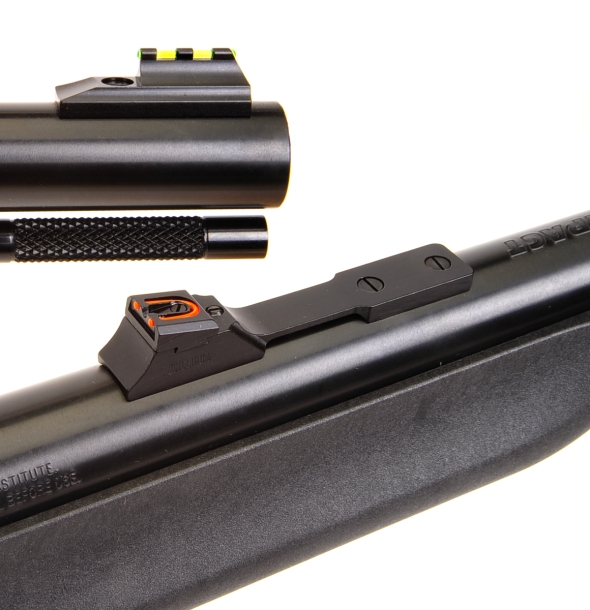
The sights on the T/C Impact are the popular Williams FireSight variety. They are adjustable, stay put in use and are very easy to pick up as a sight picture for any situation short of shooting at the noon day sun. The receiver is drilled and tapped to facilitate scope mounting and other types of optical and metallic sights. The pattern is the same as used on the Encore and Omega products.

Pulling back on the breech hood wings lets the barrel flop down for priming. The process in not much different than the T/C Encore or Contender or any other break action firearm.
I can unequivocally state, there are parts in there. Not many… still…
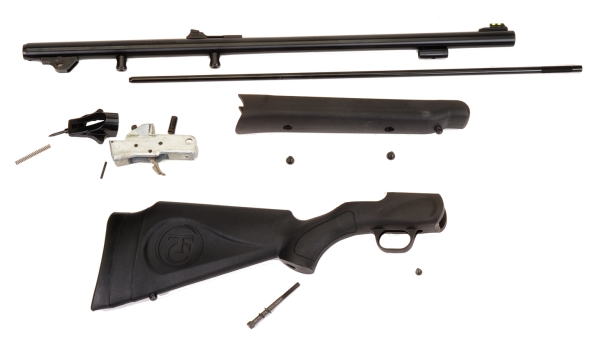
The T/C Impact is a firearm of simple design. Remove the two screws from the forearm, the one screw that passes through the pistol grip and you’ll be holding a barreled action and the forearm and buttstock will be on the bench. The hood, hood spring retaining pin and hood spring will be on the floor because most people only skim through the instructions and skip over the caution, “Watch out for the hood, pin, spring” notations. Not a problem, they all reinstall easily…. once you find them.
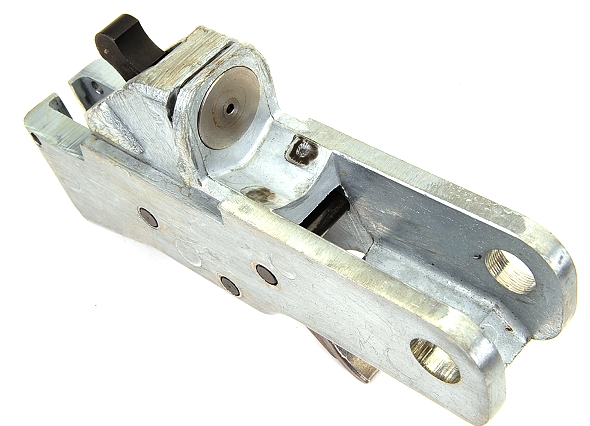
At the heart of the T/C Impact is an aluminum receiver that holds all of the fire control pieces, including a rebounding hammer, and a steel insert breech face. A little crude in finish, but functionally reliable and none of the process marks show when the firearm is assembled. The pivot pin is striated to grip the right side of the pin and slip fit through the left. So the pivot pin is fixed in the receiver and the barrel moves about the pin when the action is opened and closed. In reality, the pin is also blocked from lateral movement by the sides of the buttstock.
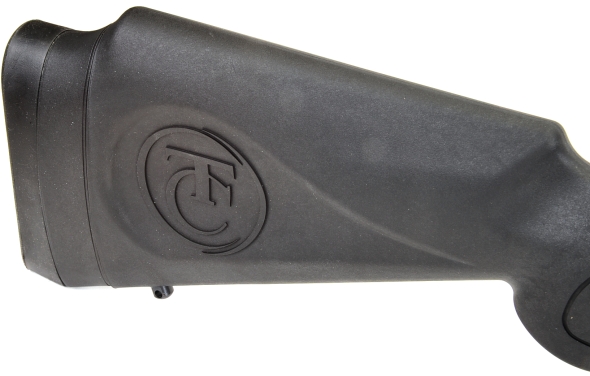
I keep forgetting who makes this firearms, T? TC? It will come to me. The 1″ spacer that resides between the stock and recoil pad can be popped out to reduce length of pull from 13.5″ to 12.5″. The recoil pad is effective and the comb height is scope worthy. Just a little bit high for open sights.
Stoke, prime, click bang…
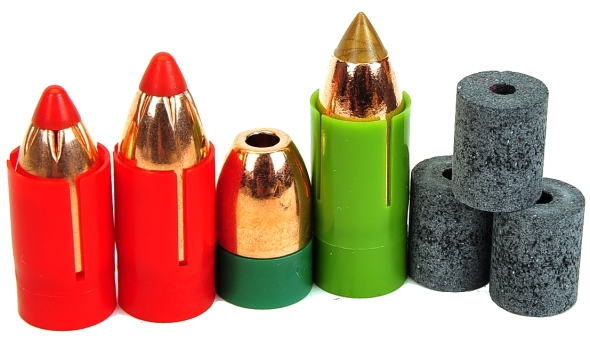
In some ways muzzleloaders are quite different, in other ways not much is new. Saboted bullets from Hornady, CVA and Remington are quite streamline for long range staying power, each with its own ballistic claim to fame. Triple Seven powder in pellet form is easy to carry, certainly easy to load and burns with nearly 20% more energy than conventional black powder. Acrid smoke, powder residue, bore scrubbing between sounds and before put away have not changed so much.
The CVA Power Belt was removed from the group after giving erratic accuracy results in both the Remington Model 700 FS Ultimate Muzzleloader and the Thompson Center Impact. Performance data for both the Remington and the Thompson Center are included in the table below. The Remington shown as a point of comparison has 50 grains more capacity than the absolute limit of 150 grains for the T/C. The Remington, at 26″, has a 2″ shorter barrel than the Thompson, however, it produced higher velocity than the T/C Impact when charged to the same levels.
| Bullet | Weight Grains |
Charge Grains |
Velocity fps Rem 26″ |
Velocity fps T/C 28″ |
| Remington AccuTip Sabot | 250 | 100 | 1767 | 1518 |
| Remington AccuTip Sabot | 250 | 150 | 2116 | 2115 |
| Remington AccuTip Sabot | 250 | 200 | 2425 | – |
| Hornady Low-Drag-Sabot SST | 250 | 100 | 1755 | 1677 |
| Hornady Low-Drag-Sabot SST | 250 | 150 | 2102 | 1992 |
| Hornady Low-Drag-Sabot SST | 250 | 200 | 2394 | – |
| Hornady Low-Drag-Sabot SST | 300 | 100 | 1647 | 1623 |
| Hornady Low-Drag-Sabot SST | 300 | 150 | 1978 | 1952 |
| Hornady Low-Drag-Sabot SST | 300 | 200 | 2252 | – |
| Remington AccuTip same as Barnes Spit-fire T-EZ | ||||
The T/C had a tighter bore than the Remington, so bore friction could have contributed to reduced velocity. The difference was enough to make initial loading the T/C Impact difficult with both Remington sabot ammo and Hornady, with the latter usually very easy to chamber. I deliberately removed accuracy data as a point of comparison because the Remington data was gathered with a scope mounted and only the factory open sights were used on the Impact. The best group shot at 100 yards with the Impact was 2.5″, however, the rest were more than twice that size; something I would attribute to my eyesight. We will run a short follow up piece addressing scoped performance.
When the smoke cleared… and it did clear…
The Thompson Center Impact is not peer to a Remington Model 700 Ultra Muzzle Loader, however, it is a very slick muzzleloader for the money and even for significantly more money. Accuracy is good, the break action system is easy to work with and the breech plug is easy to get at to pull and clean. The Impact’s FireSights are a good match for the application and they stand in sharp contrast to even the darkest targets.
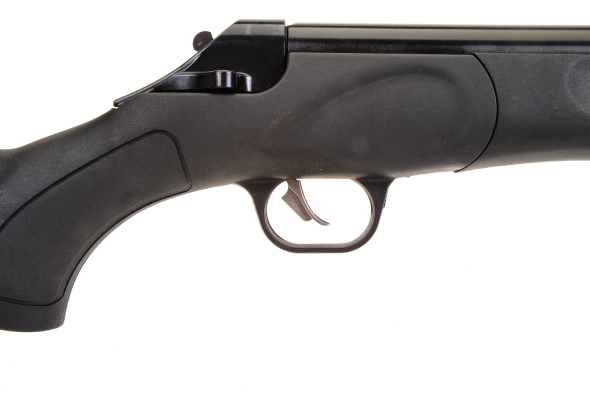
The Impact has a good trigger, set much farther back when the rifle is cocked. Pull is relatively light, it breaks cleanly and there is minimal over travel. The Impact is a well balanced muzzle loader; unlike most, it doesn’t feel like a 10 pound weight is affixed to the muzzle. The bore is tight. Without the use of a hand protecting handle at the end of the ram rod, it is tough on the hand when loading. Certainly not a deal breaker, but it takes away a quick follow up shot because running a patch and solvent down the bore between rounds is almost essential. It is possible this condition will improve with use.
It is a fun gun to shoot, it doesn’t look like an outcast amongst a group of more expensive firearms and it could easily be the gun for deer season for an experienced black powder hunter.

Email Notification